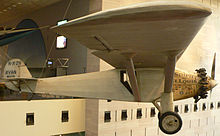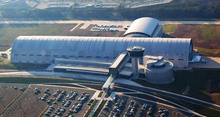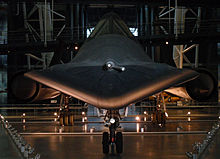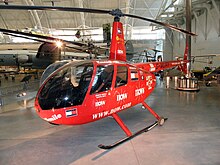National Air and Space Museum

The National Air and Space Museum ( NASM ; German " National Air and Space Museum ") is one of the Smithsonian Institution affiliated museum in the United States . It consists of three plants. Two of these are open to the public: the National Mall Museum in Washington, DC and the Steven F. Udvar-Hazy Center in Virginia .
National Mall Museum


The National Mall Museum is located in a building in the park of the same name in Washington, DC. It shows numerous exhibits from the history of aviation and space travel, including the Spirit of St. Louis or Rock from the Moon .
Among other things, the following exhibits are on display in the National Air and Space Museum:
- AAI RQ-7
- Albatros DV a
- Beechcraft Model 17
- Bell P-59
- Bell X-1
- Bucker Bü 181 B Bestmann
- Bücker Bü 133 C young master
- Enterprise NCC-1701 , original model
- Extra 260
- Focke-Achgelis Fa 330 A-1 White Wagtail
- Fokker D.VII
- Gossamer Condor , a muscle-powered aircraft
- Grob 102 Standard Astir III
- Grunau Baby II B-2
- Halberstadt CL.IV
- Lilienthal Gleiter , an original from 1894
- Lippisch DM-1
- Lockheed Martin RQ-3
- Macchi MC.202
- Martin B-26
- Messerschmitt Bf 109 G-6 Gustav
- Messerschmitt Me 262 A swallow
- Palatinate D.XII
- Schempp-Hirth Nimbus II
- Schneider-Hofmann-Rehberg SG 38
Steven F. Udvar-Hazy Center
Because a spatial expansion of the National Mall Museum was not possible, a new location was established in Virginia with the Steven F. Udvar-Hazy Center. This new location is south of Washington-Dulles-International Airport in Chantilly, Virginia . It opened in December 2003. The building is named after Steven F. Udvar-Házy , a patron of the museum, who is closely connected and well-known to the aviation industry through the ILFC .
The new complex offers much larger areas and buildings than the main building.
- At the center is the large Boeing Aviation Hangar , in which exhibits are displayed on three levels. Exhibits such as an SR-71 Blackbird , the B-29 Superfortress Enola Gay or a Concorde can be viewed there.
- The somewhat smaller James S. McDonnell Space Hangar exhibits, among other things, the Space Shuttle Discovery .
- The complex is complemented by the Donald D. Engen Observation Tower . The observation tower provides a panoramic view of Washington Dulles International Airport and its surroundings.
- The latest addition is the Mary Baker Engen Restoration Hangar , where visitors can view current restoration work on historical exhibits.
- Exhibits
The exhibition in the Steven Udvar-Házy Center includes a variety of exhibits from the field of aerospace. In addition to airplanes, helicopters and ultralight aircraft , engines and aircraft engines are also shown. Famous exhibits are:
- Bell 206L-I LongRanger II Spirit of Texas
- Bell 47
- Bell UH-1 Iroquois "Huey" Smokey III
- Bell XV-15
- B-29 Superfortress Enola Gay
- Boeing 307 Stratoliner Clipper Flying Cloud
- Boeing P-26 peashooter
- Boeing-Stearman N2S-5 Kaydet
- Concorde of Air France
- Curtiss P-40E Kittyhawk
- Dassault Falcon 20th
- Gemini 7 , capsule
- Gossamer Albatross
- Grumman A-6E Intruder
- Grumman F-14D (R) Tomcat
- Grumman F6F-3 Hellcat
- Grumman F8F Bearcat
- Kaman K-225
- Lockheed Constellation L049
- Lockheed P-38 Lightning
- Lockheed SR-71A Blackbird
- Lockheed Martin X-35B Joint Strike Fighter
- Lockheed T-33A Shooting Star
- MGM-1 Matador
- McDonnell Douglas F-4S Phantom II
- Mikoyan-Gurevich MiG-15bis Fagot B
- Mikoyan-Gurevich MiG-21F Fishbed C
- Nakajima J1N1 Gekko
- Naval Aircraft Factory N3N-3 Yellow Peril
- North American P-51C Mustang Excalibur III
- Northrop N-1
- Northrop P-61 Black Widow
- Pegasus XL
- Poseidon C-3
- Republic F-105D Thunderchief
- Republic P-47 Thunderbolt
- Robinson R22
- Robinson R44 Astro G-MURY
- Sikorsky UH-34D
- Sikorsky YH-19A
- Space Shuttle Discovery
- Virgin Atlantic GlobalFlyer
- Vought F4U ID Corsair
- Vought RF-8 Crusader
- Westland Lysander IIIA
Many representatives of German aircraft construction are also exhibited.
- Arado Ar 234 B Blitz with Walter HWK 109-500 (the only surviving aircraft of this type)
- Bachem Ba 349B-1 Natter (currently not on display)
- Bucker Bü 133C young master
- Bucker Bü 181B Bestmann
- Dornier Do 335A-1 Pfeil (the only surviving aircraft of this type)
- Focke-Achgelis Fa 330 A
- Focke-Wulf Fw 190 F
- Focke-Wulf Ta 152H-1 (currently not on display)
- Grob G 102 Standard Astir III
- Grunau Baby II B-2
- Heinkel He 162A-2 Spatz (currently not on display)
- Heinkel He 219 (only the body)
- Hoarding H IIIf
- Hoarding H IIIh (only the middle piece)
- Hoarding H VI V2
- Horten H IX V3 (in the restoration hangar)
- Junkers Ju 388 L-1 (currently not on display)
- Junkers Ju 52 / 3m ( CASA 352L)
- Messerschmitt Me 163 Comet
- Messerschmitt Me 410A-3 / U1 (currently not on display)
- Nagler-Rolz NR 54 V2
Paul E. Garber Facility
There is also another location for the museum, the Paul E. Garber Complex in Suitland-Silver Hill, Maryland.
Exhibits are processed and stored here; it is no longer open to the public.
See also
literature
- Anke Ortlepp: "To Infinity and Beyond". The National Air and Space Museum in Washington, DC , in: Zeithistorische Forschungen / Studies in Contemporary History 3 (2006), pp. 158–168.
Web links
Individual evidence
- ^ Website of the Steven F. Udvar-Hazy Center
- ↑ Boeing Aviation Hangar
- ↑ James S. McDonnell Space Hangar
- ↑ On April 19, 2012, the Space Shuttle Enterprise was replaced by the Discovery , and the Enterprise was then handed over to the Intrepid Sea-Air-Space Museum in New York City. On April 17th, the Discovery landed on the back of the Shuttle Carrier Aircraft at the neighboring Washington Dulles International Airport .
- ↑ Donald D. Engen Observation Tower ( Memento of the original from January 21, 2012 in the Internet Archive ) Info: The archive link was inserted automatically and has not yet been checked. Please check the original and archive link according to the instructions and then remove this notice.
- ↑ Mary Baker Narrow Restoration Hangar
- ↑ General information about the Steven F. Udvar-Hazy Center
- ^ Exhibits in the Steven F. Udvar-Hazy Center
Coordinates: 38 ° 53 '18 " N , 77 ° 1' 12" W.







